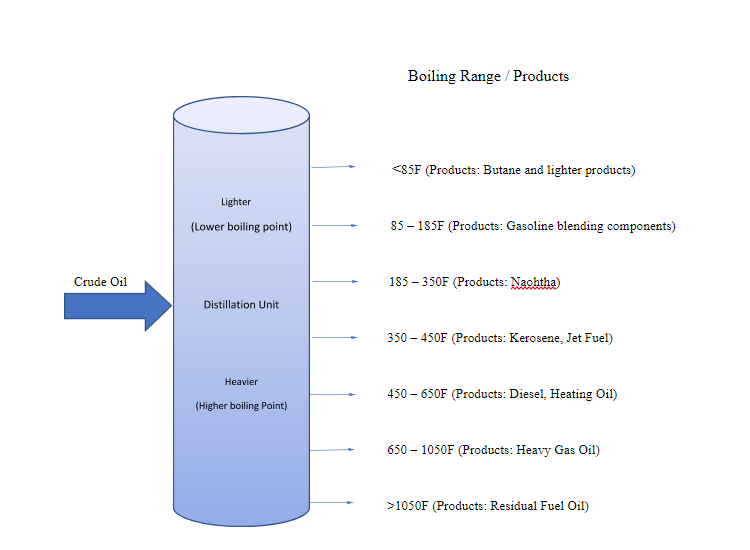Distillation is a commonly used process for separating mixtures based on differences in the conditions required to change phase of components of the mixture. To separate a mixture of liquids, the liquid can be heated to force components, which have different boiling points, into the gas phase. The gas is then condensed back into liquid form and collected. Repeating the process on the collected liquid to improve the purity of the product is called double distillation. Although the term is most commonly applied to liquids, the reverse process can be used to separate gases by liquefying components using changes in temperature and or pressure. A plant that performs distillation is called a distillery. The column used to perform distillation is called a still. A crude oil refinery is a group of industrial facilities that turns crude oil and other inputs into finished petroleum products. A refinery’s capacity refers to the maximum amount of crude oil designed to flow into the distillation unit of a refinery, also known as the crude unit.
The diagram above presents a stylized version of the distillation process. Crude oil is made up of a mixture of hydrocarbons, and the distillation process aims to separate this crude oil into broad categories of its component hydrocarbons, or “fractions.” Crude oil is first heated and then put into a distillation column, also known as a still, where different products boil off and are recovered at different temperatures. Lighter products, such as butane and other liquid petroleum (LPG), gasoline blending components, and naphtha, are recovered at the lowest temperatures. Mid-range products include jet fuel, kerosene, and distillates (such as home heating oil and diesel fuel). The heaviest products such as residual fuel oil are recovered at temperatures sometimes over 1,000 degrees Fahrenheit.

The simplest refineries stop at this point. Although not shown in the simplified diagram above, most refineries in the United States reprocess the heavier fractions into lighter products to maximize the output of the most desirable products using more sophisticated refining equipment such as catalytic crackers, reformers, and cokers.
Packed bed columns may be used for distillation of vapor liquid mixtures. Random packing media provides a large surface area for vapor liquid contact, which increases the column’s effectiveness. The style of plastic random packing that is utilized in a distillation column can affect the overall efficiency of a unit so special consideration should be given to the selection of random media during the design stage of a distillation unit. KemFlo offer the Tri-Pack style packing in 1”, 2” and 3.5”, the plastic Pall Ring in 1, 2” and 3.5”, and the plastic Saddle packing in 1” 2” and 3”. Please contact Kemflo or visit our website at www.kempac-packing.com for more information on our plastic tower packing.
